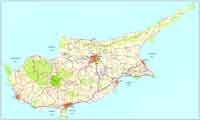.
Limnitis (Greek: Λιμνίτης, Turkish: Yeşilirmak) is a village in in the Tillyria region in Nicosia District, North Western Cyprus. The ancient Vouni Palace was located nearby. It is a small village located on the shores of the Morphou Bay. The upper parts of the village are located 20 metres above sea level but settlement extends all the way down to the sea.
History
The village is located on the North Western slopes of the Troodos Mountains. The region shows clear signs of early settlement; the ruins of Vouni Palace are located nearby, and the ruins of the city of Soli are located a little further to the East.
Modern settlement in the area began in the early 19th century. Two families settled here; the Osman family settled in Xerovounos (Turkish: Kurutepe) and the Süleyman family settled in Selemani (Turkish: Süleymaniye). The village is now exclusively inhabited by Turkish Cypriots who also formed the majority here and in neighbouring Ammadies and Xerovounos before the events in 1974 when the area was occupied by the Turkish army.
Population
The size of the original population of the village seems to be disputed. According to figures of the Cypriot Government, the 1960 population was 323 (315 Turks and 8 Greeks) and in 1973, the population was estimated at 396, all Turks. (Source:[1], click on "Sources".) Turkish sources say that the town had swelled to about 1,200 people by 1968. The number is now down to about 80 people. Turkish sources estimate that around 2,000 people originating in the town now live in United Kingdom and a further 1,500 live in Australia.
The People
The people are farmers. Growing fruit and vegetables and selling them at markets provide their main source of income. The village is known for its strawberries.

Christakis A. Kalogirou, Killed in Limnitis fighting against the Turkish Invaders , 22 July 1974, Monument in Moutoullas

| Ancient Greece
Science, Technology , Medicine , Warfare, , Biographies , Life , Cities/Places/Maps , Arts , Literature , Philosophy ,Olympics, Mythology , History , Images Medieval Greece / Byzantine Empire Science, Technology, Arts, , Warfare , Literature, Biographies, Icons, History Modern Greece Cities, Islands, Regions, Fauna/Flora ,Biographies , History , Warfare, Science/Technology, Literature, Music , Arts , Film/Actors , Sport , Fashion --- |
Retrieved from "http://en.wikipedia.org/"
All text is available under the terms of the GNU Free Documentation License

